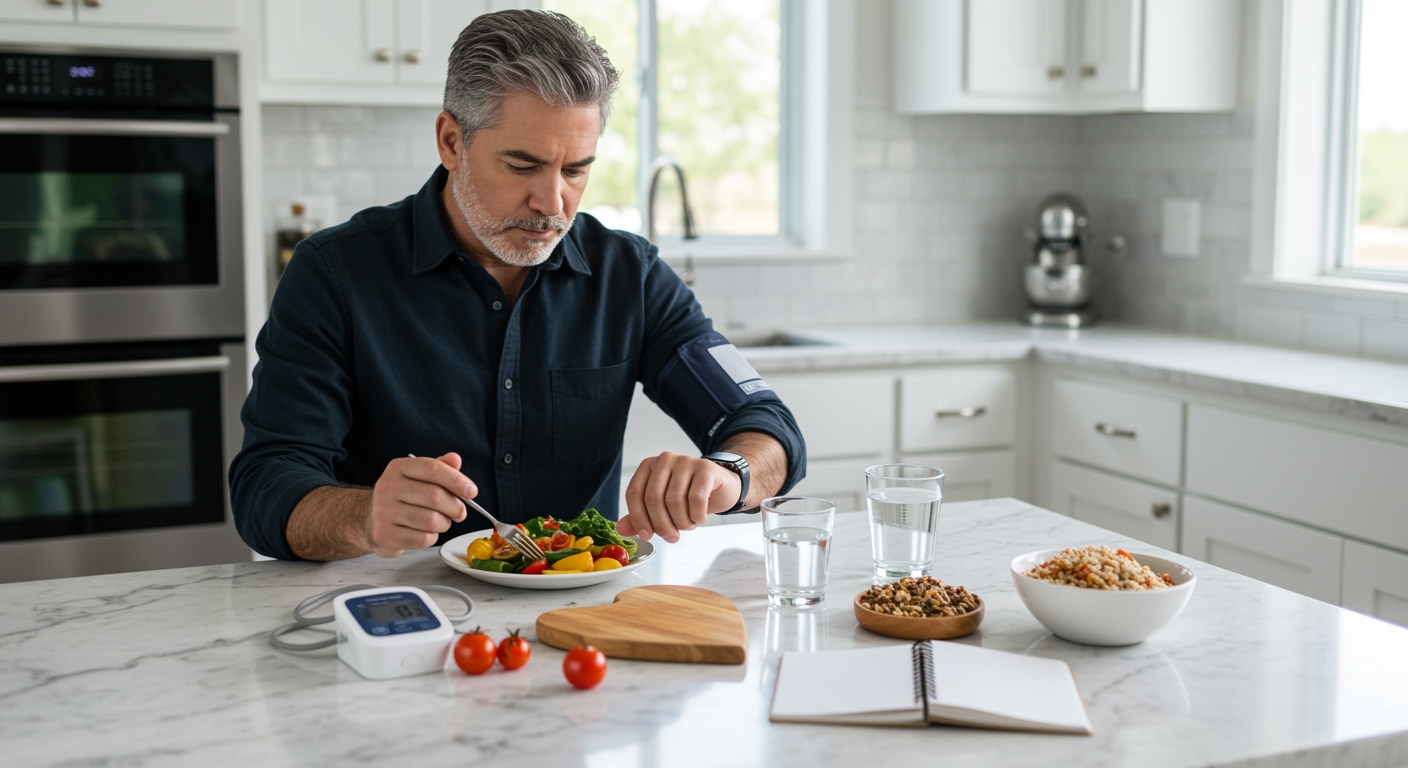✪ Key Takeaway: Yes, eating slowly can help lower blood pressure by reducing stress hormones and improving digestion.
Introduction
Your fork hits the plate faster than your heart beats during a workout.
You might wonder if the speed at which you eat affects your blood pressure readings. Many people with hypertension focus on what they eat but ignore how they eat.
Hi, I’m Abdur, your nutrition coach and today I’m going to explain exactly how eating speed impacts your blood pressure and what you can do about it.
What Happens When You Eat Too Fast?
Fast eating triggers a cascade of physiological responses that directly impact your cardiovascular system.
When you eat quickly, your body releases higher amounts of stress hormones like cortisol and adrenaline. These hormones cause your blood vessels to constrict and your heart rate to increase.
Your digestive system also struggles to keep up with the rapid food intake. This creates additional stress on your body and can lead to inflammation throughout your system.
Research shows that people who eat quickly have significantly higher blood pressure readings compared to those who eat slowly. The difference can be as much as 10-15 points in systolic pressure.
Fast eating also leads to overeating because your brain needs about 20 minutes to register fullness signals. This extra food intake puts additional strain on your cardiovascular system.
✪ Fact: Fast eaters consume 88 calories more per meal than slow eaters on average.
How Does Slow Eating Lower Blood Pressure?
Slow eating activates your parasympathetic nervous system, which is responsible for rest and digestion.
When you eat slowly, your body produces more nitric oxide, a compound that helps relax blood vessels and improve blood flow. This natural vasodilation effect directly lowers blood pressure.
Mindful eating also reduces the production of stress hormones. Lower cortisol levels mean less constriction of blood vessels and a more relaxed cardiovascular system.
Your digestive system works more efficiently when you eat slowly. Better digestion means less inflammation and oxidative stress throughout your body.
Slow eating helps you recognize satiety signals earlier, preventing overeating. This maintains a healthy weight, which is crucial for blood pressure control.
Studies demonstrate that people who practice slow eating show measurable improvements in blood pressure within just 8 weeks of changing their eating habits.
✪ Pro Tip: Put your fork down between bites to naturally slow your eating pace.
What Does The Science Say About Eating Speed?
Multiple research studies confirm the strong connection between eating speed and blood pressure levels.
A large-scale study involving over 1,000 participants found that fast eaters had 11.6% higher systolic blood pressure compared to slow eaters. The researchers controlled for other factors like age, weight, and diet quality.
Another study showed that people who ate meals in less than 5 minutes had twice the risk of developing metabolic syndrome, which includes high blood pressure as a key component.
Japanese researchers discovered that teaching people to eat slowly reduced their blood pressure by an average of 8 mmHg systolic and 5 mmHg diastolic within 12 weeks.
The mechanism appears to be related to improved insulin sensitivity and reduced inflammation markers when people eat more slowly.
Brain imaging studies show that slow eating activates different neural pathways compared to fast eating, leading to better appetite regulation and stress management.
✪ Note: The blood pressure benefits of slow eating appear within 2-4 weeks of consistent practice.
How Can You Start Eating Slower Today?
Changing your eating speed requires practical strategies that fit into your daily routine.
Start by setting a timer for 20 minutes at each meal. This gives you a target timeframe and helps you become more aware of your natural eating pace.
Chew each bite thoroughly before swallowing. Aim for 20-30 chews per bite, especially for harder foods like vegetables and proteins. This mechanical breakdown aids digestion and slows your pace naturally.
Put your utensils down between bites and take a sip of water. This simple pause gives your brain time to process satiety signals and prevents mindless rapid eating.
Eliminate distractions during meals. Turn off the television, put away your phone, and focus solely on your food. Mindful eating naturally leads to slower consumption.
Practice portion control by serving smaller amounts initially. You can always get more food, but starting with less reduces the temptation to eat quickly through large portions.
Engage in conversation during meals when eating with others. Social interaction naturally slows eating pace and makes meals more enjoyable and stress-reducing.
✪ Pro Tip: Use smaller plates and utensils to naturally encourage slower, more mindful eating habits.
The Bottom Line
Eating slowly is a simple yet powerful tool for managing blood pressure that costs nothing and requires no special equipment.
Your fork can be your best medicine when you learn to use it slowly and the benefits extend far beyond blood pressure to include better digestion, weight management, and overall cardiovascular health.
I would love to hear about your experiences with changing your eating speed or any questions you might have about implementing these strategies in your daily routine, so please share your thoughts in the comments below.
References
At NutritionCrown, we use quality and credible sources to ensure our content is accurate and trustworthy. Below are the sources referenced in creating this article:
- PMC: Eating Speed and Metabolic Health
- University of Maryland: Eating Behaviors and Cardiovascular Risk
- PMC: Fast Eating and Cardiometabolic Risk
- Cleveland Clinic: Why Do I Eat So Fast





